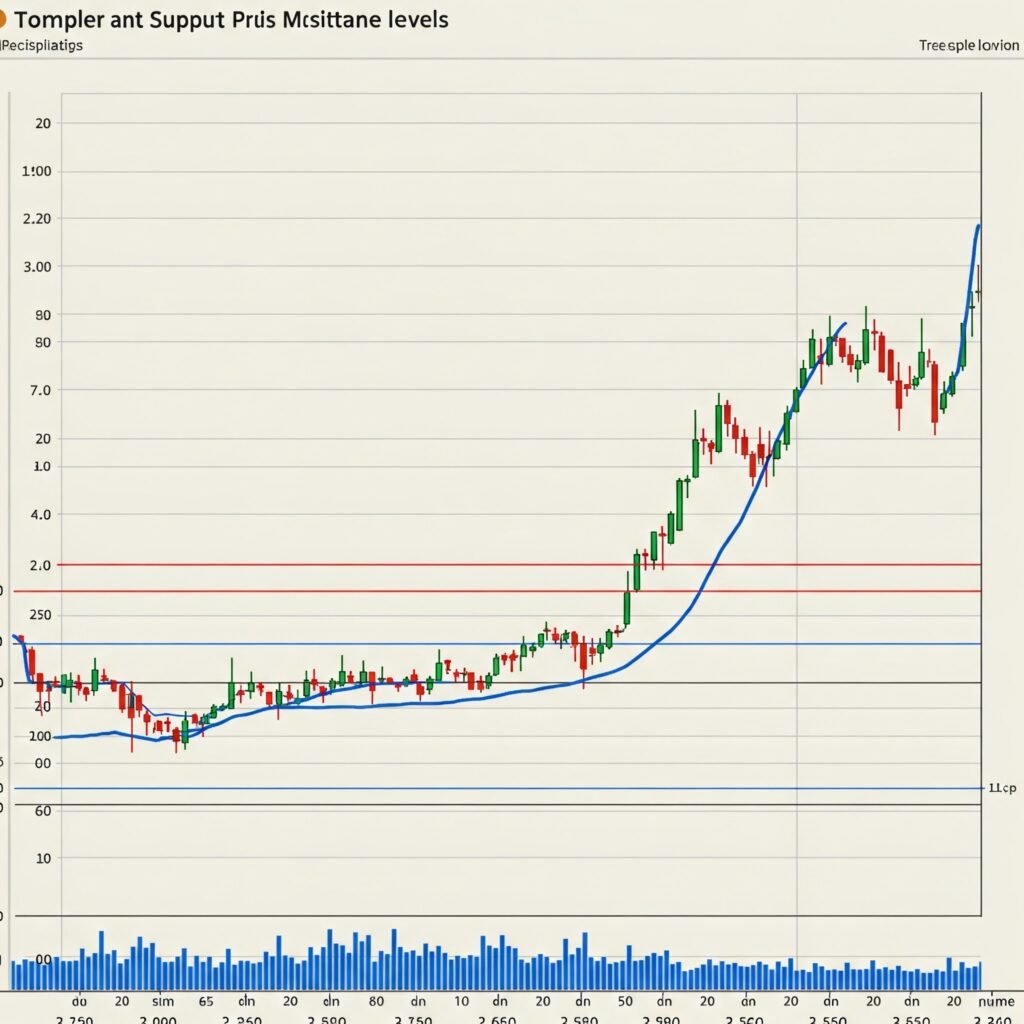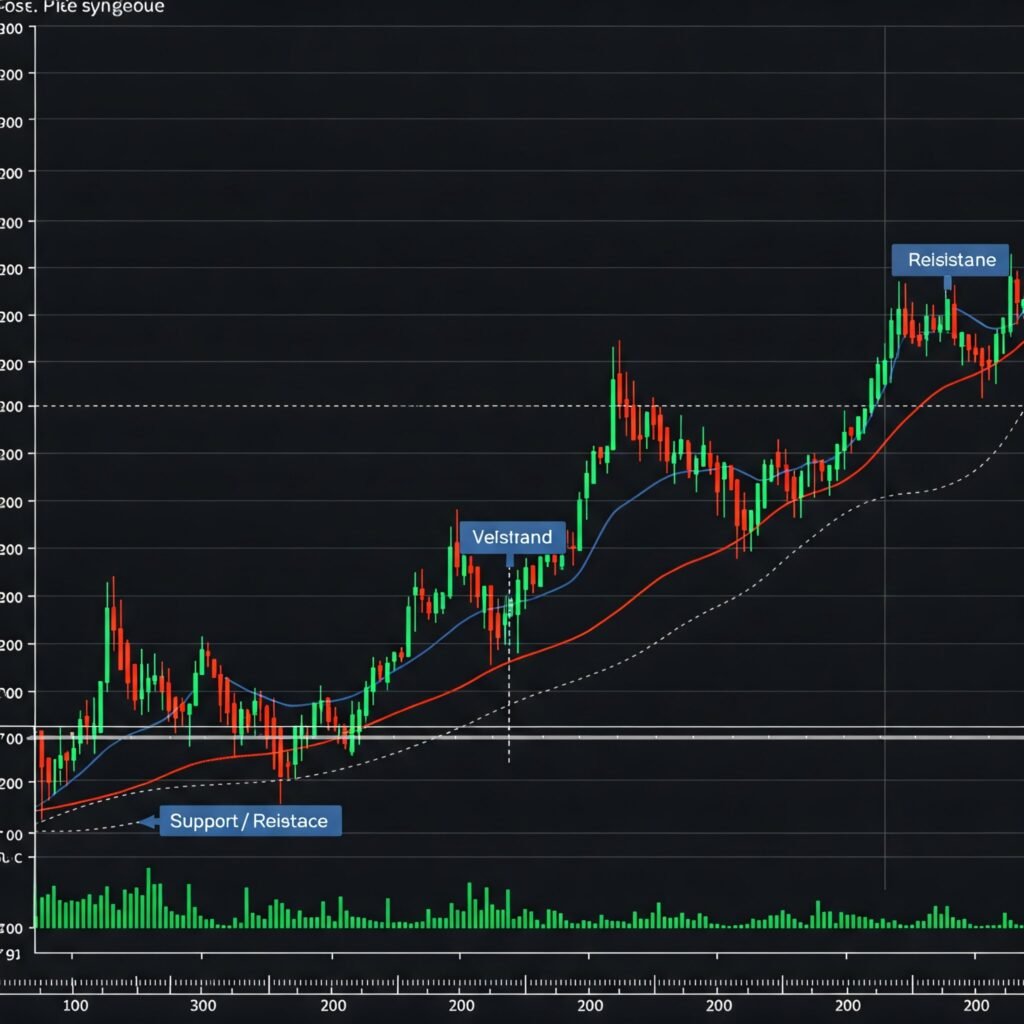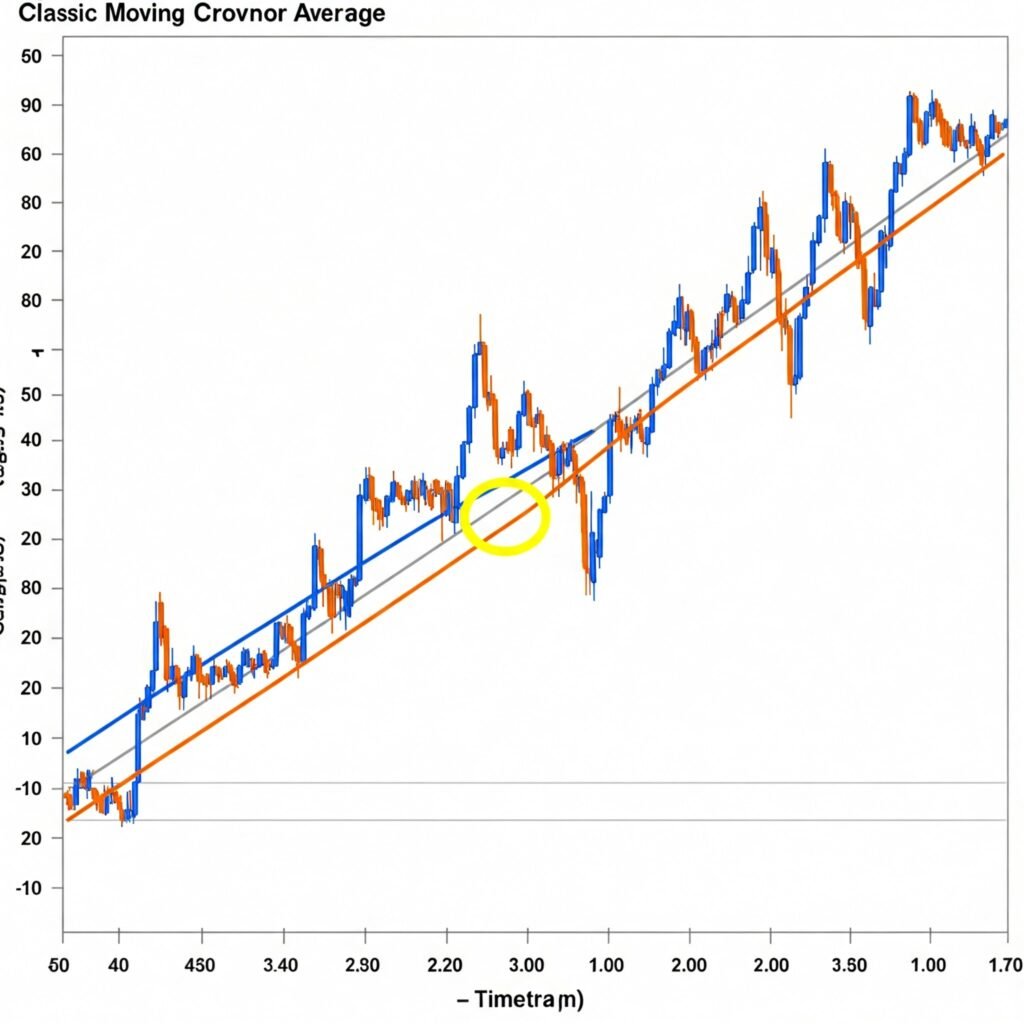Before we delve into the individual strategies, it’s crucial to understand that most proven swing trading strategies are rooted in technical analysis. Technical analysis involves studying historical price charts, patterns, and indicators to forecast future price movements.
Key technical analysis concepts you’ll encounter in swing trading include:
- Support and Resistance Levels: These are price levels where a stock or asset has historically struggled to break above (resistance) or fall below (support). Identifying these levels is fundamental to many swing trading strategies for determining potential entry and exit points.
- Trendlines: These lines connect a series of price highs or lows and help visualize the direction and strength of a trend. Trading with the trend is a core principle in many successful swing trading approaches.
- Technical Indicators: These are mathematical calculations based on price and/or volume that provide insights into market momentum, volatility, and potential trend changes. Popular indicators for swing trading include Moving Averages, the Relative Strength Index (RSI), MACD, and Bollinger Bands.

Now, let’s explore five proven swing trading strategies that actually work.
1. Trend Following Strategy: Riding the Wave
The trend following strategy is perhaps one of the most straightforward and widely used proven swing trading strategies. The core idea is simple: identify an existing trend (uptrend or downtrend) and enter trades in the direction of that trend. The assumption is that a stock or asset that is trending is likely to continue in that direction for a period.
How it Works:
- Identify the Trend: Use tools like moving averages (e.g., 50-day or 200-day moving average) or simply observe higher highs and higher lows for an uptrend, or lower highs and lower lows for a downtrend on daily or weekly charts.
- Entry Signal: Look for opportunities to join the trend during pullbacks or consolidations. In an uptrend, you might buy on a dip towards a key moving average or a support level. In a downtrend, you would look to short sell on a bounce towards a moving average or resistance level.
- Exit Strategy: Exit the trade when the trend shows signs of weakening or reversing. This could be signaled by a break of a trendline, a moving average crossover, or bearish/bullish candlestick patterns at resistance/support.
Actionable Takeaway: Focus on trading in the direction of the prevailing trend. Don’t try to pick tops or bottoms; aim to capture the main move within the trend.
Example: Imagine a stock has been consistently making higher highs and higher lows, trading above its 50-day moving average. A trend following swing trader would look to buy the stock on a pullback towards the 50-day moving average, setting a stop-loss below the recent swing low and a profit target at the next potential resistance level.
2. Support and Resistance Strategy: Trading the Bounce and Reverse
Trading bounces off support and reversals at resistance is another cornerstone of proven swing trading strategies. This method relies on the principle that historical support and resistance levels tend to act as price barriers.
How it Works:
- Identify Support and Resistance: Analyze price charts to find levels where the price has repeatedly bounced or reversed in the past. These levels are often easily identifiable horizontal lines.
- Entry Signal: For a long trade, enter when the price bounces off a significant support level, ideally with a bullish confirmation like a bullish engulfing candlestick pattern. For a short trade, enter when the price reverses at a strong resistance level, with bearish confirmation.
- Exit Strategy: Set your profit target at the opposing resistance (for a long trade) or support (for a short trade) level. Place your stop-loss just below the support (for long) or above the resistance (for short) to limit potential losses if the level breaks.
Actionable Takeaway: Support and resistance levels provide clear reference points for potential entries and exits. Look for price action confirmation at these levels before entering a trade.
Example: Suppose a stock has repeatedly bounced off the $50 level. A swing trader employing the support and resistance strategy might place a buy order near $50 when the price approaches this level, especially if bullish signals appear on the chart. Their profit target might be at the next resistance level, say $55, with a stop-loss placed just below $50.

3. Breakout Trading Strategy: Catching the Momentum
The breakout trading strategy is a popular and effective swing trading method that aims to capitalize on the initial momentum when a stock’s price breaks out of a defined trading range or pattern. Breakouts often signal the start of a new trend or the continuation of an existing one with increased conviction.
How it Works:
- Identify Consolidation Patterns: Look for periods where the price has been trading within a narrow range, forming patterns like rectangles, triangles, or flags. These patterns indicate a الفترة of indecision before a potential directional move.
- Entry Signal: Enter a long trade when the price breaks convincingly above the upper boundary of the consolidation pattern (resistance) on increased volume. Enter a short trade when the price breaks below the lower boundary (support) on increased volume.
- Exit Strategy: Set a profit target based on the potential measured move of the pattern or at the next significant support or resistance level. Place your stop-loss just inside the breakout level to protect against false breakouts.
Actionable Takeaway: Volume confirmation is crucial for breakout trades. A breakout on low volume is less likely to be sustainable.
Example: Consider a stock that has been trading between $70 and $75 for several weeks, forming a rectangle pattern. A breakout swing trader would set an alert for the price moving above $75. If the price breaks above $75 with a surge in trading volume, they would enter a long position, anticipating a move higher. A stop-loss would be placed just below $75.
4. Moving Average Crossover Strategy: Signaling Trend Shifts
Moving averages are fundamental technical indicators, and their crossovers can provide powerful signals for proven swing trading strategies. A moving average crossover occurs when a shorter-term moving average crosses above or below a longer-term moving average.
How it Works:
- Select Moving Averages: Common combinations include the 10-day and 30-day moving averages, or the 20-day and 50-day moving averages. The specific periods can be adjusted based on your trading style and the asset you are trading.
- Entry Signal: A bullish crossover (e.g., the 10-day MA crossing above the 30-day MA) is often considered a buy signal, suggesting increasing bullish momentum and a potential uptrend. A bearish crossover (e.g., the 10-day MA crossing below the 30-day MA) is a sell signal, indicating increasing bearish momentum and a potential downtrend.
- Exit Strategy: Exit the trade when an opposing crossover occurs, signaling a potential trend reversal. You can also use profit targets based on support and resistance levels or a predetermined risk-reward ratio.
Actionable Takeaway: Moving average crossovers are lagging indicators, meaning they confirm a trend change after it has begun. Use them in conjunction with other analysis to improve timing.
Example: If the 20-day moving average of a stock crosses above its 50-day moving average, a swing trader using this strategy might interpret this as a bullish signal and enter a long position. They would hold the position until the 20-day moving average crosses back below the 50-day moving average, or until their profit target is reached.

5. Momentum Trading Strategy: Riding the Strength
Momentum trading is a proven swing trading strategy that focuses on stocks or assets that are showing strong directional movement and trading volume. The idea is to ride the “momentum” of the price move until it shows signs of slowing down or reversing.
How it Works:
- Identify Strong Momentum: Use indicators like the Relative Strength Index (RSI) or the Stochastic Oscillator to identify overbought (for potential short trades in a downtrend) or oversold (for potential long trades in an uptrend) conditions within the context of the larger trend. Look for stocks that have had significant price moves on increasing volume.
- Entry Signal: Enter a trade in the direction of the momentum after a slight pullback or consolidation. For example, in a strong uptrend, you might buy when the RSI pulls back from overbought territory but remains above 50, indicating that bullish momentum is still dominant.
- Exit Strategy: Exit the trade when momentum starts to wane. This could be signaled by the momentum indicator reversing direction, a bearish divergence (price making higher highs while the indicator makes lower highs), or bearish candlestick patterns.
Actionable Takeaway: Momentum can change quickly. Be prepared to exit trades promptly if the momentum shifts against you.
Example: Suppose a stock has been on a strong upward run, and the RSI is in overbought territory (above 70). A momentum swing trader might wait for a slight pullback in price and the RSI to dip back towards 50 before entering a long position, anticipating the continuation of the upward momentum. They would place a stop-loss and monitor the RSI and price action closely for signs of a reversal.
Implementing Proven Swing Trading Strategies Effectively
Successfully implementing these proven swing trading strategies requires more than just understanding the entry and exit signals. Here are some additional tips for enhancing your swing trading:
- Risk Management is Crucial: Always define your risk before entering a trade. Use stop-loss orders to limit potential losses on each trade. A common rule is to risk only a small percentage (e.g., 1-2%) of your trading capital on any single trade.
- Develop a Trading Plan: Don’t trade impulsively. Have a clear trading plan that outlines your strategy, entry and exit criteria, risk management rules, and the assets you will trade.
- Practice with Paper Trading: Before risking real capital, practice your chosen strategies with a demo account. This allows you to get comfortable with the strategy and refine your approach without financial risk.
- Keep a Trading Journal: Document your trades, including the strategy used, entry and exit points, profit or loss, and your observations. This helps you learn from your successes and mistakes.
- Stay Informed: While swing trading is primarily based on technical analysis, it’s essential to be aware of major news events or economic reports that could impact the market or the assets you are trading.
- Be Patient and Disciplined: Not every trade will be a winner. Stick to your trading plan, avoid emotional decisions, and be patient for the right trading opportunities to arise.
Conclusion: Finding Your Edge with Proven Swing Trading Strategies
Swing trading, when approached systematically with proven strategies, can be a rewarding way to participate in the financial markets. By understanding and applying strategies like trend following, support and resistance trading, breakout trading, moving average crossovers, and momentum trading, you equip yourself with powerful tools to identify opportunities and manage risk.
Remember that success in swing trading, like any form of trading, requires continuous learning, discipline, and adaptation. Start with one or two strategies that resonate with you, practice diligently, and gradually expand your repertoire as you gain experience. With a solid foundation in technical analysis and a commitment to your trading plan, you can increase your chances of success and navigate the exciting world of swing trading with confidence.





